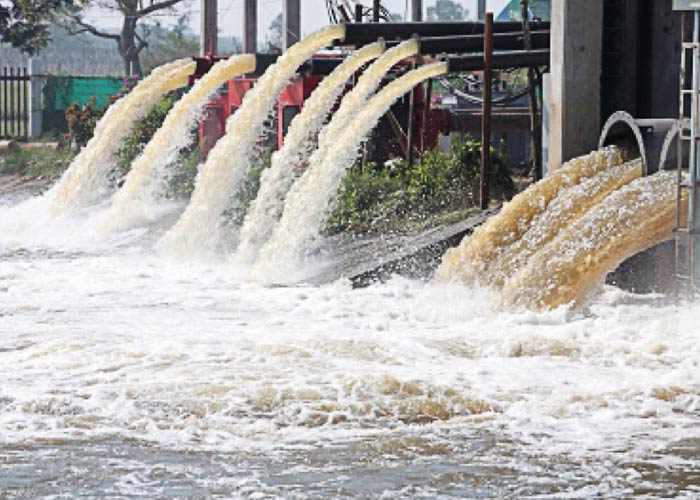Acid rain is a grave problem which needs global attention. It has harmful impact on plants, aquatic animals, forests, freshwaters, soils, and infrastructure. It causes death of insects and aquatic life-forms, and weathering of stone buildings and statues. It corrodes monuments of historic importance.
Every year, thousands of buildings and bridges are damaged due to this. In addition, it has impacts on human heath too. Loss of biodiversity, increased soil acidity and destruction of forests are among some of the many harmful effects of acid rain. Solutions to prevent emission of gases causing acid rain need to be adopted at the earliest to prevent occurrence of this environmental disaster.
Meaning of Acidic Rain
Acid rain is defined as rain or any other form of precipitation that has elevated levels of hydrogen ions (low pH), or in simple words is acidic. The cause of acid rain is emissions of sulphur dioxide and nitrogen oxide. These react with the water molecules in the atmosphere to produce acidic rain water. Nitrogen oxides are naturally produced by lightning strikes while volcanic eruptions are major source of sulphur dioxide production.
Forms of Acid Deposition
There are mainly two forms of acid deposition as discussed below-
- Wet Deposition:In places where the weather is wet, acids fall to the ground in forms which include fog, rain, mist or snow. It usually happens when the wind blows the acidic chemicals in the air. The acid is removed from the atmosphere and deposited on the earth’s surface. When this acid flows through the ground, it has harmful effects on animal, plant and aquatic life. It also affects marine life because the water from drain flows into rivers and canals and is then mixed up with sea water.
- Dry Deposition:In areas where the weather is dry, if the wind blows the acidic chemicals in the air, the acidic pollutants mix with smoke or dust and fall to the ground as dry particles. These may also stick to the ground and surfaces of trees, buildings or cars. Dry deposition gives birth to almost 50% of the acidic pollutants in the atmosphere. These deposited acidic pollutants are washed away from earth surface by rainstorms.
Facts of Acid Rain
Here are some of the important facts regarding acid rain:
- Apart from the sulphur and nitrogen oxides, volcanic eruptions, burning coal and even rotting plant life can give rise to acid rain.
- Acid rain usually tastes or smells similar to the usual normal rain.
- The sulphur dioxide and nitrogen oxide that give rise to acid rain also cause diseases like cancer, asthma and heart ailments.
- The acid rain can cut off the light and nutrient supply of the leaves thus, actually killing them. It also poisons the soil and plant life by changing the acid level of soil.
- When acid rain falls in the water bodies like lakes, streams or rivers, it change the pH of the water making it toxic for the aquatic life.
- Some lakes have been declared entirely dead because of acid rain.
- Acid rain has a pH of 4.3 (similar to that of orange juice or vinegar), while that of pure water is 7.
- Rain is not the only type of precipitation that is termed as acid rain. Fog, snow and even dust can be equally acidic.
- Acid rain can be neutralized in the same way as an acid.
- Sulphur and nitrogen dioxides, major contributors to acid rain are present in an abundant amount in the atmosphere.
Acid Rain Formula
Here are the chemical equations involved in the formation of sulphur dioxide and nitrogen oxides that are major contributors to acid rain. Both sulphur dioxide and nitrogen dioxide react with water to form acids.
- Sulphur dioxide reacts with water to form sulphurous acid.
SO2 (g) + H2O (l) -> H2SO3 (aq)
- Sulphurous acid and oxygen react to form sulphuric acid.
2H2SO3 (aq) + O2 (g) -> 2H2SO4 (aq)
- In the same way, nitrogen dioxide reacts with H2O (water) to form a mixture of nitric acid and nitrous acid.
2NO2 (g) + H2O (l) -> HNO3 (aq) + HNO2 (aq)
- Nitrous acid and oxygen react to form nitric acid.
2HNO2 (aq) + O2 (g) -> 2HNO3 (aq)
The sulphuric acid and nitric acid thus formed are the major acids present in acid rain. These are soluble in water.
Causes of Acid Rain
Acid rain Formation is done by both natural and man-made sources. But, the main cause is the combustion of fossil fuels which emits the oxides of sulphur (SO2) and nitrogen (NOx).
- Natural Sources of Acid Rain
The major natural agent causing acid rain is volcanic eruption. Volcanic emissions contain acid producing gases. This creates higher than usual amounts of acid in rain and other forms of precipitation like fog and snow. Acid rain forming gases are also found in decaying vegetation or wildfires. Other biological processes within the environment can also generate the oxides of nitrogen and sulphur. A typical example of biological contributor of sulphur into the atmosphere is dimethyl sulphide. Lighting strikes are responsible for producing nitric oxides. It then reacts with water molecules resulting in production of nitric acid, thereby forming acid rain.
- Man-made Sources of Acid Rain
Human activities are the primary contributors of acid rain. The factors which produce acid rain causing gases are factories, automobiles and power generation facilities. The use of coal for electrical power generation, in particular, is the biggest contributor to acid rain causing gaseous emissions. Sulphur dioxide (SO2) and nitrogen oxides (NOx) are produced by burning coal. Automobiles and factories also release gases in high amounts. This is a major problem in urban regions where there is heavy vehicular traffic. These gases react in the atmosphere with water and oxygen, thus producing high amounts of acid rain in these areas.
Effects of Acid Rain
The adverse side effects of acid rain are not limited to one place, nor are it limited to areas of industrial and transport sources which emit sulphur dioxide and nitrous oxide. It also affects the highly expansive areas away from these sources; because the factors responsible for acid rain are exist in the gaseous form, which are spread far and wide by air and clouds. Due to the sulphur dioxide and nitrous oxide emitted from the factories located in Britain and Germany, acid rain occurs in Norway, Sweden and Finland, as a result of which the biodiversity of most of these areas faces grave threat.
It has been shown that acid rain has adverse impacts on plants, animals, humans and even infrastructure. How acid rain affects all these is described below.
- Affects Aquatic Environment:Acid rain falls directly on aquatic bodies. It also gets run off the roads to flow into rivers and lakes. The acids get accumulated in the water, thereby lowering the overall pH of the water. If the pH level falls below 4.8, the conditions become hostile for the survival of aquatic life. Fish and other aquatic life-forms are affected as the pH and aluminium concentrations are altered. Below the level of pH 5, most fish eggs cannot hatch. This can also kill adult fish. Another impact is on biodiversity, which suffers grave erosion. In lakes and rivers, varieties of species including fish, plant and insects have been depleted due to acid rain.
- Very Harmful for Vegetation Cover and Forests:High altitude forests and vegetation cover are damaged by the deposition of acid rain water. Since the trees and plants here are mostly covered by acidic fogs and clouds, the water gets deposited on them. The ecological harmony is also disrupted by the acid rain, which results in death of many plants and trees. Acid rain also affects trees by destroying their leaves, damaging the bark and arresting their growth. Germany, Poland and Switzerland are countries where forest damage due to acid rain is maximum.
- Damaging Effects on the Architecture and Buildings:Acid rain corrodes the buildings constructed with limestone by reacting with the minerals. This leaves the building weak and susceptible to decay. Not only this; automobiles, airplanes, steel bridges and pipes are also affected by acid rain. The damage caused to the old heritage buildings is irreplaceable.
- Effects on the Soil Chemistry and Biology:Soil is highly affected by acid rain. Soil microbes and soil chemical compositions are damaged or reversed due to acid rain. The soil needs to maintain an optimum pH level for the continuity of biological activity. Acid rain water that seeps into the soil increases the soil pH, which affects the biological and chemical activities possessed by the soil. As a result, microorganisms that cannot adapt to changes in pH die. High level of acid in soil also denatures enzymes for the soil microbes. Hydrogen ions leach away nutrients such as calcium and magnesium from the soil.
- Effects on the Health of Human Beings: The presence of sulphur dioxide and nitrogen oxide gases and derivatives like sulphates and nitrates in the atmosphere degrades visibility and can cause accidents. Humans are not directly affected by acid rain because the water is too diluted to cause health complications. However, the dry depositions of these gases can cause serious health problems when inhaled. Some of these include lung and heart problems like bronchitis and asthma.
Acid Rain and Ozone Layer Depletion
Ozone is a colourless gas found in the upper atmosphere or stratosphere. The ozone gas layer is what which protects us from the harmful ultraviolet radiations of the sun. The layer of ozone gas absorbs these harmful radiations thereby preventing the UV rays from entering the earth’s atmosphere.
Ultraviolet radiations are electromagnetic waves emitted by the sun. If the UV rays enter the earth’s atmosphere, they can lead to various environmental and health issues. Ozone layer depletion, thus is very harmful for both the environment, human and animal life. It is one of the most serious problems faced by the Planet Earth today. It is also a major cause of the problem of global warming, yet another serious issue.
The major cause of ozone layer depletion is the emission of chemicals that are called the CFCs or chlorofluorocarbons. As these reach the upper atmosphere, they react with ultra violet rays to release free chlorine atoms. The chlorine atoms react with ozone gas, thereby depleting the ozone layer.
The ozone layer depletion is not directly related to the problem of acid rain. It is possible that these two have a subtle link as both are the results of industrial processes. Both are serious problems that need attention immediately if we want to protect the world.
Solutions to Acid Rain
Although international treaties to reduce greenhouse emissions have been signed and implemented throughout Europe and North America, their effects are limited, especially in the rapidly developing countries of Asia and South America, which are very dependent on coal and oil for energy. Since the largest source of acid rain are coal-based power plants, it is more important than ever to develop alternate sources of energy. Otherwise, acid rain will continue to destroy trees, forests, wildlife and historic buildings and monuments.
Concerned citizens can take steps to save energy and start reducing their dependence on fossil fuels which cause acid rain. Some of the solutions to the problem of acid rain are described below:
- Exhaust Pipes, Chimney and other Smoke Discharging Funnels must be Cleaned
- Electric power for energy requirements mostly comes from combustion of fossil fuels such as coal and natural gas. This generates nitrogen oxides (NOx) and sulphur dioxide (SO2), both major contributors to acid rain.
- Some of the technical solutions to lesser gas generation can be used like use of coal having low sulphur as well as use of other devices called as scrubbers.
- Scrubbing can also be used. It is a process also called as flue-gas desulfurization used to chemically eliminate sulphur dioxide from the gases leaving the smokestacks/chimney. The process eliminates up to 95% of SO2 gas.
- Use of natural gases in power generation instead of burning coal is another solution to reduce SO2 emission.
- Catalytic converters can be used to reduce emission of nitrogen oxides from automobile fossil fuel combustions. Catalytic converters are needed to be fixed on the exhaust pipe system.
- Use of Alternate Energy Sources
A wide range of alternative energy sources generate electrical power. Examples are wind energy, solar energy, geothermal energy, nuclear power and hydropower. These energy sources become alternative electrical power sources to fossil fuels. Cleaner substitutes of fossil fuels include fuel cells, batteries and natural gas. Using sustainable energy is the only solution that can safeguard mankind’s future and prevent phenomena such as acid rain.
- We Need to Restore our Damaged Environment
Liming process can be used. It is a process that people can adopt for repairing the damage caused by acid rain. Adding lime into acidic surface waters balances the acidity. This practice has been used extensively to balance pH levels. The disadvantage of this is that liming is an expensive method which has to be done repeatedly. Moreover, it is only a short-term solution to the damages caused by NOx and SO2. However, it is one process which ensures the survival of aquatic life forms by balancing the water acidity.
- We must follow the Sustainable Living Habits
We directly or indirectly contribute to sulphur and nitrogen oxide emissions. So, we must be more aware of energy conservation and ways of reducing emissions. Some simple ways of doing this are turning off lights or electrical appliances when not in use; use of public transport and using energy efficient electrical appliances.
Conclusion
Acid rain is a serious issue and increasing its level day by day, so it needs a huge attention globally. All the reasons which are responsible for increment in the causes of acid rain must be discussed and solved. It is affecting the environment and health of living beings on the earth on its own level but it may be a deadly issue in the coming future.







